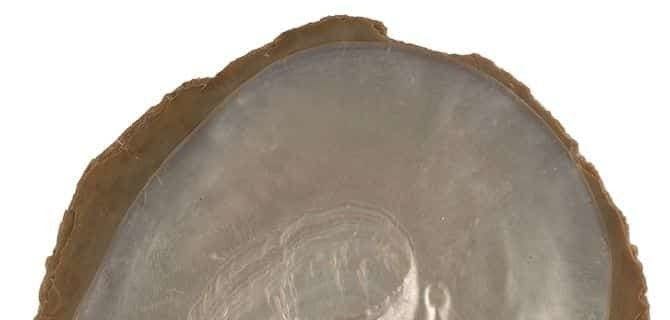The Mayans used seashells as dental implants, and researchers have shown that small chunks of mother-of-pearl, the iridescent lining of oysters’ and other mollusks’ shells, induce bone formation in both cell culture and animal studies. Why this works, however, has been a mystery. Researchers are now a step closer to the answer. A new work […]

The Mayans used seashells as dental implants, and researchers have shown that small chunks of mother-of-pearl, the iridescent lining of oysters’ and other mollusks’ shells, induce bone formation in both cell culture and animal studies. Why this works, however, has been a mystery. Researchers are now a step closer to the answer. A new work shows that a polymer replica of the physical structure of the material’s surface is enough to induce stem cells to become bone. Such surface patterning could be used for engineering bone, the researchers say.
That shells trigger bone growth is somewhat surprising: Mother-of-pearl, also known as nacre, is a calcium-carbonate-based mineral with a different structure than the main mineral in bone, which is made of calcium phosphate. Studies have shown that powdered nacre induces stem cells to produce calcium phosphate. However, stem cells also respond to physical cues from nanoscopic bumps and ridges on surfaces. To separate the effect of nacre’s chemical cues from its surface patterns, a team led by Maggie Cusackof the University of Stirling and Matthew John Dalby of the University of Glasgow decided to recreate nacre’s nanoscopic pattern using a different material.
First, the researchers filled the inside of an oyster shell with a silicone polymer, allowed it to cure, and peeled it away. Then they covered the resulting polymer stamp with molten polycaprolactone, a biocompatible polymer. After it solidified and was removed from the silicon, the team used three-dimensional stereo-scanning electron microscopy to show that they had recreated the terraced surface structure of nacre on the polymer surface. Then, the researchers cultured human mesenchymal stem cells on the nacre replica. After five weeks, the cells had increased expression of genes related to bone development compared with cells grown on a flat surface of the same polymer, indicating that nacre’s structure alone can stimulate bone growth.
To study the effect of different physical and chemical cues on growing bone, the team grew stem cells on natural nacre from an oyster, the polymer nacre replica, and a textured array made of polymethylmethacrylate known to help bone growth. They also grew cells using two different established cell culture methods. Bone formed under all conditions, but differing metabolic responses indicated that the bone produced could have different properties. Raman spectroscopy revealed that cells grown on the nacre replica produced the most crystalline bone of all the conditions tested.
Crystallinity is just one property that can affect bone strength, Cusack says, and they don’t have a simple relationship. By knowing that the physical structure of nacre affects crystallinity, researchers could change the spacing of the terraced pattern and see how this changes bone properties, she says. Being able to tweak this property in isolation could help researchers optimize the overall features of engineered bone for specific applications.
One problem in interpreting these initial experiments might come from the changeable structure of nacre, notes Daniel Chappard, a bone remodeling and biomaterials expert at the University of Angers. His research shows that natural nacre alters its crystal structure in some cell culture media. So the nacre surface pattern the researchers created on the polymer stamp might not be the same one that cells experience when cultured on the natural nacre surface, he notes.
This article is reproduced with permission from C&EN (© American Chemical Society). The article was first published on August 2, 2017.
